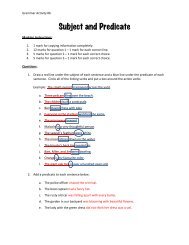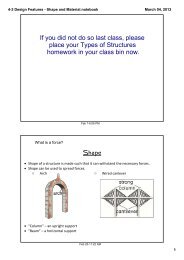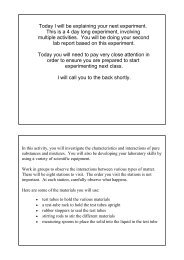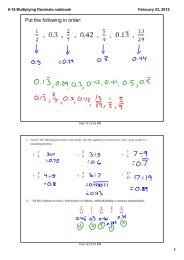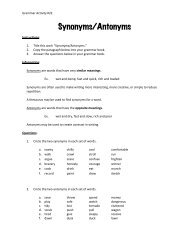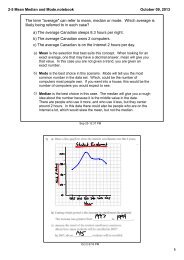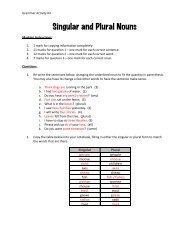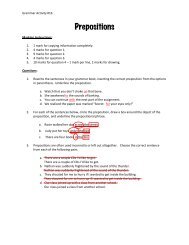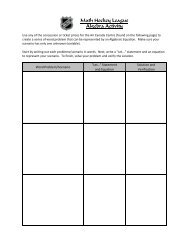Oral Presentations
Oral Presentations
Oral Presentations
Create successful ePaper yourself
Turn your PDF publications into a flip-book with our unique Google optimized e-Paper software.
<strong>Oral</strong> <strong>Presentations</strong><br />
<strong>Oral</strong> presentations are a common requirement in many courses. They<br />
may be short or long, include pictures or other visual aids, and be done<br />
individually or in a group.<br />
Planning and structuring an oral presentation is similar to the<br />
process of writing an essay, except you need to be conscious of a live<br />
audience and use spoken language instead of written.<br />
The major steps in oral presentations are planning, structuring,<br />
preparing, and presenting.<br />
1. Plan<br />
Purpose - What is important about your topic/book? What are the<br />
important events or focus of your presentation?<br />
Audience - To whom are you presenting? What does your audience<br />
expect to gain from listening to you?<br />
2. Structure<br />
Like an essay, an oral presentation needs an introduction, body and<br />
conclusion.<br />
Introduction - Give a brief (and relevant) anecdote or provocative<br />
question to engage your audience or introduce your topic with an<br />
engaging sentence or statement.<br />
Body – Stay on topic and include all the criteria and relevant<br />
information for the presentation.<br />
Conclusion - End presentation with a clear concluding statement, or<br />
maybe a final question for your audience to ponder.<br />
- Don’t end presentations with “that’s it” or “…and yeah.”
3. Prepare<br />
The more prepared you feel, the less nervous you're likely to be.<br />
There are a few key considerations in preparation for an oral<br />
presentation, namely time limits, speaking from notes, body<br />
language and use of voice.<br />
• Time limits:<br />
- Practice the presentation a number of times to get the pacing<br />
right and ensure you fit the information into the time<br />
provided.<br />
- Don't finish too early either or it seems that you don't have<br />
sufficient knowledge of the topic/book/material.<br />
• Speak from notes:<br />
- Try not to read your entire paper as you will tend to lose eye<br />
contact, intonation and good posture.<br />
- Use bullet points and then rehearse filling in the gaps while<br />
practicing.<br />
• Body language:<br />
- Try to use roving eye contact with the audience while<br />
maintaining good posture and using appropriate gestures<br />
with your hands.<br />
• Voice:<br />
- Speak loudly, clearly and slowly.<br />
- Use pauses effectively when making particular points, and<br />
maintain interesting intonation patterns - avoid speaking in<br />
a monotone voice.<br />
4. Present:<br />
If you've prepared well, you should be ready for a confident<br />
presentation. By now you should have the presentation fitting<br />
comfortably into the time limits and you should be speaking fluently<br />
just from dot-point notes. When you're actually in front of the<br />
audience, remember your body language and voice projection. Try to<br />
relax and enjoy the experience of sharing your information. Don’t<br />
forget to ask if anyone has any questions at the end.



